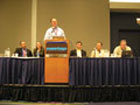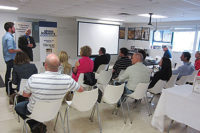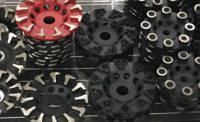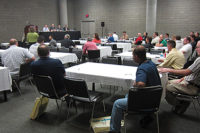
Stone fabricators from around the country gathered in a open “Fabricator Forum” during Coverings 2009, and they discussed a range of topics.
Transcribed by Michael Reis
Each year at Coverings, stone fabricators from around the country gather in a open “Fabricator Forum,” where they are invited to share their questions and experiences with a panel of industry experts. This year’s forum took place on the final day of Coverings, April 24, in Chicago, IL, and while attendance was down from previous forums, there was no shortage of topics to be discussed during the two-hour session.
Panelists at the forum included:
• Brett Rugo, Rugo Stone LLC, Lorton, VA
• Rejeana Ellis, Rocky Tops, Greensboro, NC
• Scott Lardner, Rocky Mountain Stone, Albuquerque, NM (moderator)
• Duane Naquin, Stone Interiors, Columbia, SC
• Guido Gliori, Grazzini Brothers & Co., Eagan, MN
• Michael Twiss, Columbia Stone, Inc., Tualatin, OR
The following is a summary of the discussions that took place during the 2009 Coverings “Fabricator Forum.”
How has the economic downturn affected your business?
Twiss:The market on the West Coast has been difficult to say the least. We closed one plant, with one-third of our staff. Declines in commercial work have also taken their toll. We have really taken an aggressive approach to cutting back. We have scaled down to our core group to maintain our business.
Grazzini:Our firm does work around the country, and we have had some luck with larger projects. We have found some pockets of work - some public projects like airport renovations. We’ve had partial layoffs of our fabrication crew and support staff. There are plenty of projects to bid, but the price tags are scaring developers.
Naquin:We have operations in Columbia, SC, and Mobile, AL. We sold off two other shops. South Carolina is down 50%, and the Gulf Coast market is down about 70%. We have scaled back to where we need to be. We had a staff of 150, and that’s down to about 50. We are seeing sales tick up slightly, and it looks like we’ve bottomed out.

Panelists at the forum included (from left): Brett Rugo, Rugo Stone LLC, Lorton, VA; Rejeana Ellis, Rocky Tops, Greensboro, NC; Scott Lardner, Rocky Mountain Stone, Albuquerque, NM (moderator); Duane Naquin, Stone Interiors, Columbia, SC; Guido Gliori, Grazzini Brothers & Co., Eagan, MN; and Michael Twiss, Columbia Stone, Inc., Tualatin, OR.
Ellis: We do residential fabrication in Greensboro, SC, and it has completely turned over to a remodel market - not even a full remodel market; just countertops. We are down 20 to 30%, but we haven’t had to do any layoffs yet.
Rugo: We are a commercial contractor. We import slabs, and our shop is dependent on the commercial market. Our shop crews are currently working 55 to 60 hours per week because we have a backlog, but we expect that to end by the end of this year. We believe that 2010 will be a lean year.
How are companies templating? Are they using digital templating systems to scribe the walls?
Naquin: I think the time savings with digital templating really only comes when you have complicated systems in your shop. I find the laser-based systems to be the quickest as opposed to the photo-based ones, although the photo-based systems capture more data.
Grazzini: For us, the benefit of digital templating is that we can do more with the data. We can manipulate it better than we can with hard templates, and digital templating shouldn’t take any longer.
Twiss: We use the Prodim Proliner, and it is tied in with our waterjet and CNC work. Meanwhile, the hard templates are tied to our bridge saw. We don’t go all one way or another.
Ellis: We also use a combination. We use assembled sticks for some projects, but for our commercial work, we do digital templating. The digital templating works best with our CNC, and we can plot full templates.
Rugo: We also use the Proliner, and it is linked in the field to a laptop. We can even print a copy for the client on site. In the shop, it helps us with both our CNC saw and CNC router.
How are you able to maintain quality control as your company grows?
Naquin: When we were at our largest, we had a Quality Control Inspector for each job. The crew would lay out the pieces, and the inspector signs off on every single job. It was extra important in our case because our fabricators are paid by the square foot, so we don’t want people cutting corners to push out more work.
Rugo: We have a single person who is responsible for quality control before it is loaded on the A-frame or crated. They have a checklist that they follow, and once it passes, we have a light-glue sticker that is initialed and placed on the blind surfaces of the piece. The customers like this practice as well, as it demonstrates quality control and accountability.
Is anyone using digital nesting software?
Twiss: We aren’t using a digital system, but we do allow customers to be a part of the job layout for an extra fee. We have mostly high-end customers, and they understand this. Also, if the layout determined by a customer calls for extra slabs, they will obviously pay for that as well.
Ellis: Our salespeople will do a physical layout with the customers.
Brian Briggs, GranQuartz (former fabricator and audience member): People who use the nesting software can also use it to help their customers understand that things can go wrong. They can illustrate that seam locations can change or other issues. People can use this as the basis to write a clause in the contract.
What are shops doing to “go green” in their operations?
Rugo: A commercial project received LEED points for using materials that have been quarried within 500 miles of the jobsite, so for a lot of our work, stones like Virginia Mist granite and Vermont marble will qualify. We market local stones with a “green” logo. People are really excited to use local products.
Lardner: The Natural Stone Council has also been conducting life-cycle tests.
Jim Hieb, Marble Institute of America (audience member): In addition to the 500-mile rule, these life-cycle analyses are part of a scientific and academic process. Some preliminary results can be found at www.genuinestone.org.
How are shops recycling their waste?
Rugo: We sort our waste, and we separate wood, stone and office waste. With the stone, we break down the pieces to manageable sizes. Our Dumpster costs are actually less now that we separate it out.
We use a filter press from Water Treatment Technologies for our water treatment, and our only water loss in the shop comes from evaporation.
Naquin: We crush as much stone as we can and use it in our yard, but a lot of it is hauled off.
Lardner: There is a hydraulic stone “stamper” that allows you to create pavers from waste. We have eaten through most of our waste, and it is sold through out landscape yard. The issue that a lot of shops have is how to remove the polish, because that doesn’t work for pavers. We have a sister company in New Mexico, and we use their tumbler to remove the polish.
How are shops marketing themselves in this down economy?
Twiss: We have increased spending on our advertising and marketing materials by 20 to 30%. We are also spending more time visiting with contractors. We also work with cabinet makers because we have found that contractors like to work with millwork professionals.
In terms of contact, I’m against e-mail. I believe that people still make a connection with other people, and it’s best that they know you when they are making their decisions. You really have to be in touch with customers on a personal level.
Grazzini: I agree. People do business with people they like. Even if you aren’t into marketing, this is something to remember. If you’re not out there forging relationships, you’re missing out. You need to know your customers, and they have to like you.
What about outside the commercial sector? What are people doing to market themselves in the residential sector?
Naquin: We work through dealers, cabinet shops and Big Box retailers. But even though you may have a contract with a Big Box, their people don’t have to be selling stone - they sell a lot of different countertop materials. So you have to make sure they know you and respect your company and its abilities.
Ellis: We do some local magazine advertising, and we are also networking with our local homebuilding association.
Rugo: I know of good response from E-Newsletters, especially ones that advertise special inventory or products that would draw interest.
Briggs: Another option is approaching condominium associations and offering them a group rate if six or more people in the complex sign up for new countertops. You might even turn some of the ones doing renovations into salespeople because they will want others to sign up in order for everyone to get a group discount.
Naquin: We also work with neighborhood associations, and we agree to give 10% of the proceeds back to the association. This is a concept that can work with other types of organizations as well.
Rugo: We are a commercial contractor. We import slabs, and our shop is dependent on the commercial market. Our shop crews are currently working 55 to 60 hours per week because we have a backlog, but we expect that to end by the end of this year. We believe that 2010 will be a lean year.
How are companies templating? Are they using digital templating systems to scribe the walls?
Naquin: I think the time savings with digital templating really only comes when you have complicated systems in your shop. I find the laser-based systems to be the quickest as opposed to the photo-based ones, although the photo-based systems capture more data.
Grazzini: For us, the benefit of digital templating is that we can do more with the data. We can manipulate it better than we can with hard templates, and digital templating shouldn’t take any longer.
Twiss: We use the Prodim Proliner, and it is tied in with our waterjet and CNC work. Meanwhile, the hard templates are tied to our bridge saw. We don’t go all one way or another.
Ellis: We also use a combination. We use assembled sticks for some projects, but for our commercial work, we do digital templating. The digital templating works best with our CNC, and we can plot full templates.
Rugo: We also use the Proliner, and it is linked in the field to a laptop. We can even print a copy for the client on site. In the shop, it helps us with both our CNC saw and CNC router.
How are you able to maintain quality control as your company grows?
Naquin: When we were at our largest, we had a Quality Control Inspector for each job. The crew would lay out the pieces, and the inspector signs off on every single job. It was extra important in our case because our fabricators are paid by the square foot, so we don’t want people cutting corners to push out more work.
Rugo: We have a single person who is responsible for quality control before it is loaded on the A-frame or crated. They have a checklist that they follow, and once it passes, we have a light-glue sticker that is initialed and placed on the blind surfaces of the piece. The customers like this practice as well, as it demonstrates quality control and accountability.
Is anyone using digital nesting software?
Twiss: We aren’t using a digital system, but we do allow customers to be a part of the job layout for an extra fee. We have mostly high-end customers, and they understand this. Also, if the layout determined by a customer calls for extra slabs, they will obviously pay for that as well.
Ellis: Our salespeople will do a physical layout with the customers.
Brian Briggs, GranQuartz (former fabricator and audience member): People who use the nesting software can also use it to help their customers understand that things can go wrong. They can illustrate that seam locations can change or other issues. People can use this as the basis to write a clause in the contract.
What are shops doing to “go green” in their operations?
Rugo: A commercial project received LEED points for using materials that have been quarried within 500 miles of the jobsite, so for a lot of our work, stones like Virginia Mist granite and Vermont marble will qualify. We market local stones with a “green” logo. People are really excited to use local products.
Lardner: The Natural Stone Council has also been conducting life-cycle tests.
Jim Hieb, Marble Institute of America (audience member): In addition to the 500-mile rule, these life-cycle analyses are part of a scientific and academic process. Some preliminary results can be found at www.genuinestone.org.
How are shops recycling their waste?
Rugo: We sort our waste, and we separate wood, stone and office waste. With the stone, we break down the pieces to manageable sizes. Our Dumpster costs are actually less now that we separate it out.
We use a filter press from Water Treatment Technologies for our water treatment, and our only water loss in the shop comes from evaporation.
Naquin: We crush as much stone as we can and use it in our yard, but a lot of it is hauled off.
Lardner: There is a hydraulic stone “stamper” that allows you to create pavers from waste. We have eaten through most of our waste, and it is sold through out landscape yard. The issue that a lot of shops have is how to remove the polish, because that doesn’t work for pavers. We have a sister company in New Mexico, and we use their tumbler to remove the polish.
How are shops marketing themselves in this down economy?
Twiss: We have increased spending on our advertising and marketing materials by 20 to 30%. We are also spending more time visiting with contractors. We also work with cabinet makers because we have found that contractors like to work with millwork professionals.
In terms of contact, I’m against e-mail. I believe that people still make a connection with other people, and it’s best that they know you when they are making their decisions. You really have to be in touch with customers on a personal level.
Grazzini: I agree. People do business with people they like. Even if you aren’t into marketing, this is something to remember. If you’re not out there forging relationships, you’re missing out. You need to know your customers, and they have to like you.
What about outside the commercial sector? What are people doing to market themselves in the residential sector?
Naquin: We work through dealers, cabinet shops and Big Box retailers. But even though you may have a contract with a Big Box, their people don’t have to be selling stone - they sell a lot of different countertop materials. So you have to make sure they know you and respect your company and its abilities.
Ellis: We do some local magazine advertising, and we are also networking with our local homebuilding association.
Rugo: I know of good response from E-Newsletters, especially ones that advertise special inventory or products that would draw interest.
Briggs: Another option is approaching condominium associations and offering them a group rate if six or more people in the complex sign up for new countertops. You might even turn some of the ones doing renovations into salespeople because they will want others to sign up in order for everyone to get a group discount.
Naquin: We also work with neighborhood associations, and we agree to give 10% of the proceeds back to the association. This is a concept that can work with other types of organizations as well.
What kind of warranties are shops offering their customers?
Naquin: We have found that “lifetime warranties” have a lot more credence when they are offered by larger companies - like Home Depot. It’s just a matter of customer comfort level.
Lardner: Most don’t warrant all that much anyhow. It is basically a marketing ploy. We don’t have many call-backs anyway.
How much engineered stone are shops seeing these days?
Naquin: We offer it, but nine out of 10 times, the customer converts to granite. Very often, the granite will be cheaper, but it still pays for us to offer both.
The one thing we don’t like is when people buy something out of fear - fears with granite and radon or staining, etc. We want to educate the customer and base their decision on that.
Ellis: For us, the customers tend to go with engineered stone based on color; they can get a shade that they won’t get in natural stone. (Editor’s note: A designer present in the audience echoed this sentiment. She also pointed out that the consistency of engineered stone may be a favorable option for clients building a second home who may not want to travel to approve the slabs.)
What about resin-treated slabs?
Naquin: A lot of fabricators may not know this, but the amount of resin on the face of the slab is only about 1%. When you’re trying to match the edge of the stone to the face, the color enhancers will typically work, and some wood stains have worked as well. We want to achieve a consistent finish that will last over a long time period. We’re not taking a shortcut over something that would work better.
Lardner: Another thing to consider is that UV light will break down the resin if you are storing your slabs outside - even in the short term.
Naquin: This is also the case with engineered stone.
What are shops doing in terms of sealers? Are you sealing countertops in the shop? What information are you giving out?
Naquin: All of our work for Home Depot is pre-sealed. Even our non-Home Depot work is frequently pre-sealed. We are even sealing our engineered stone because we have heard that some varieties can be tough to clean.
Ellis: We are also sealing everything, and we stress to the customers that it will have to be re-sealed down the road.
Briggs: Sealing has to take place more often if the customer is using a more aggressive product, such as Clorox Clean-Up.


